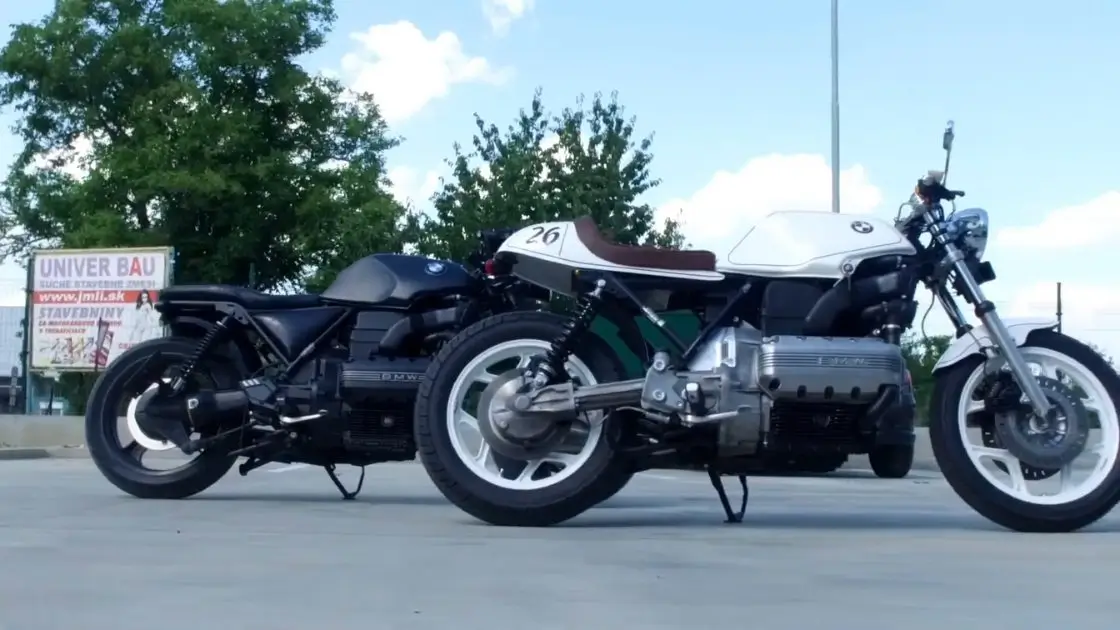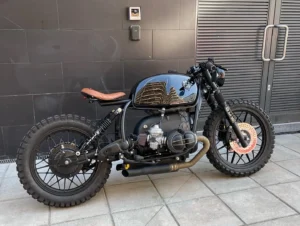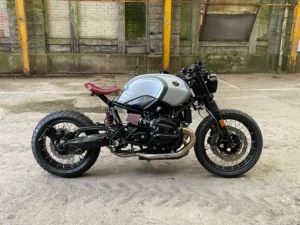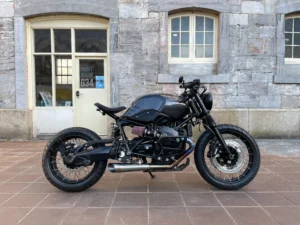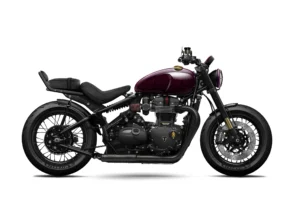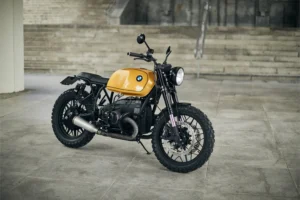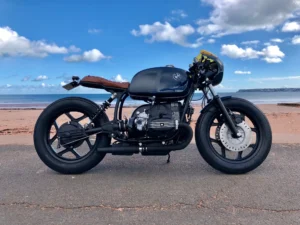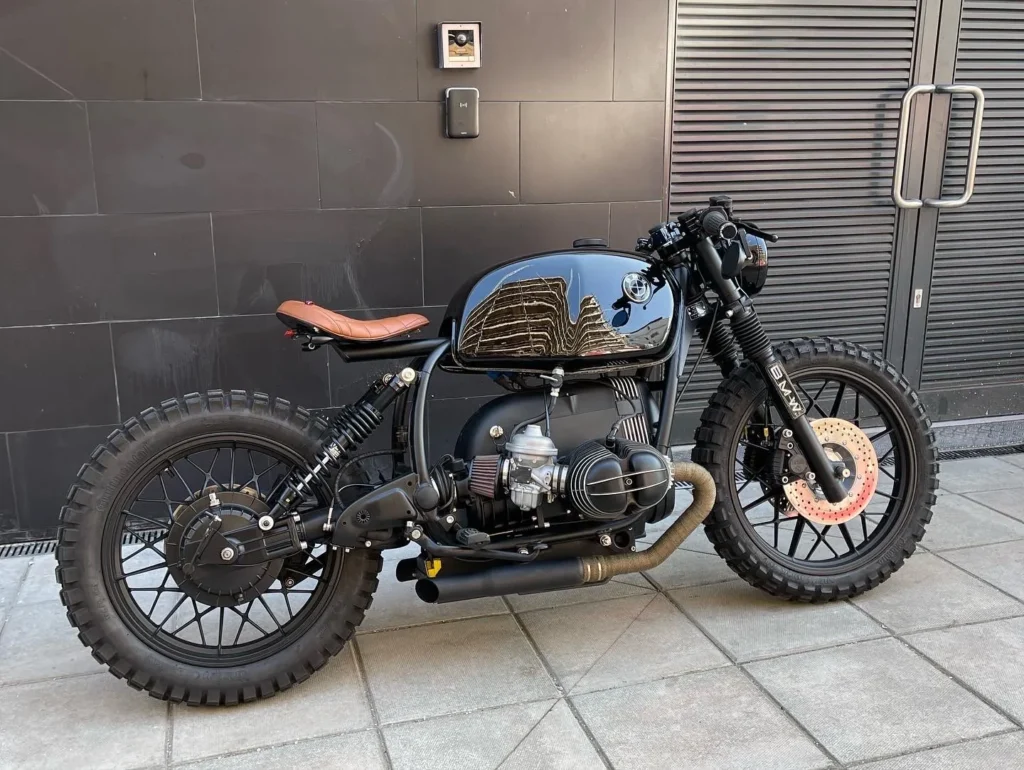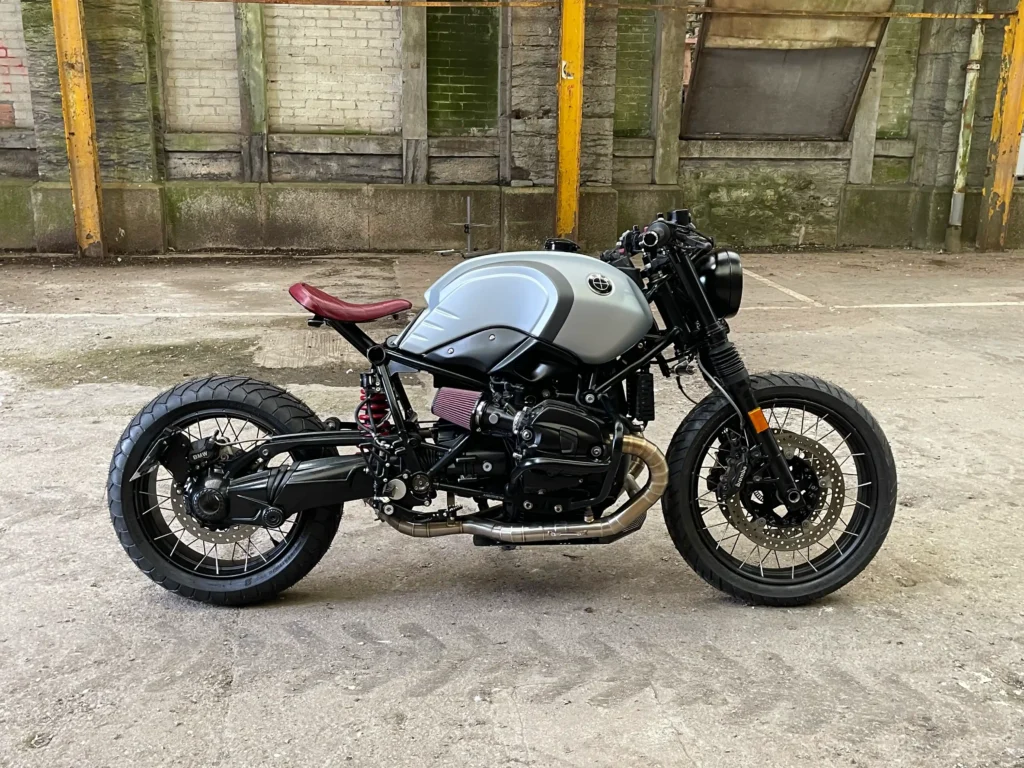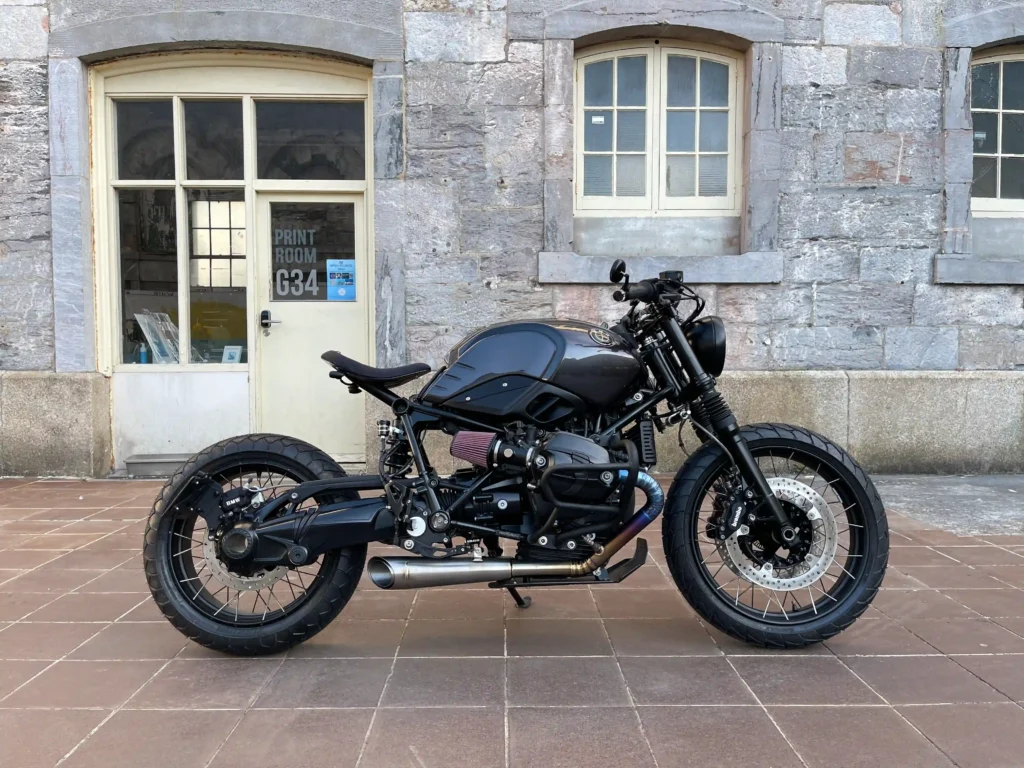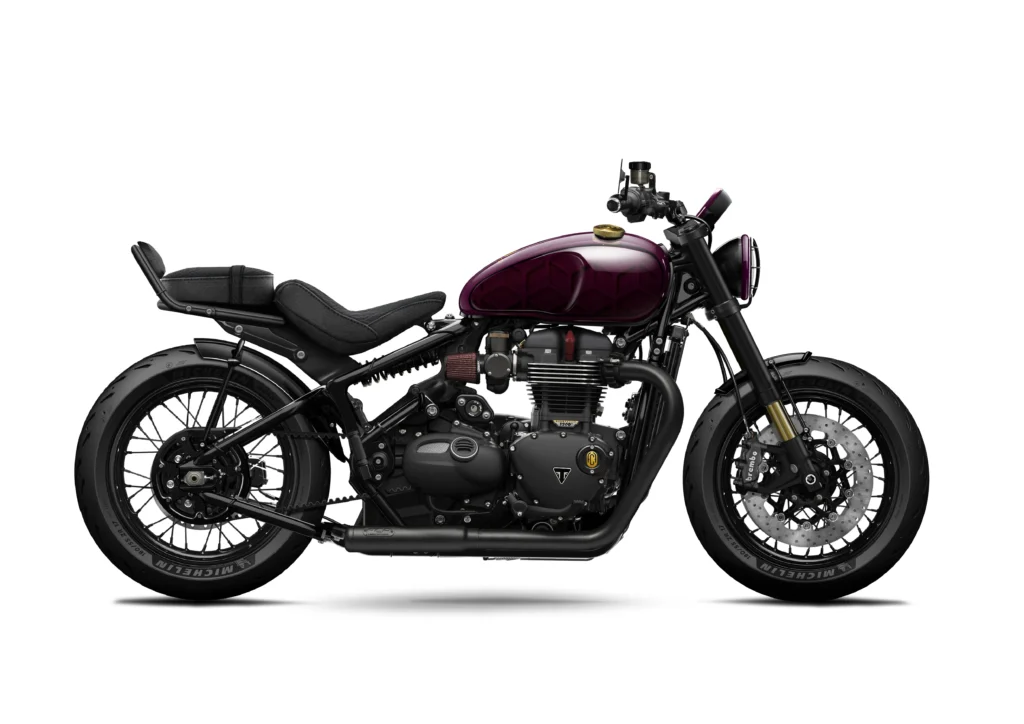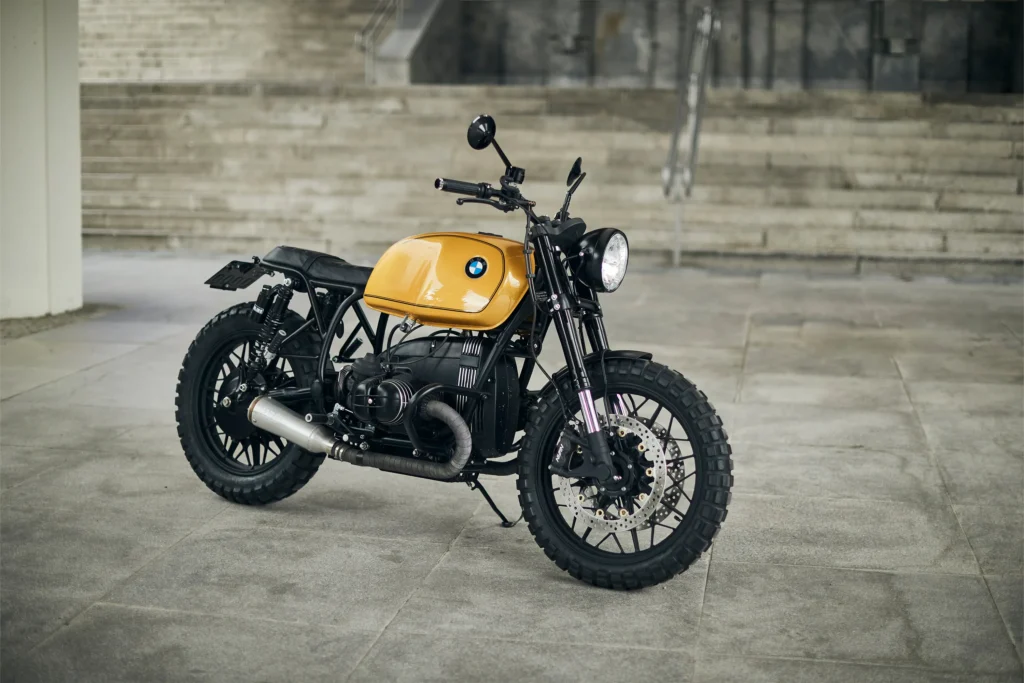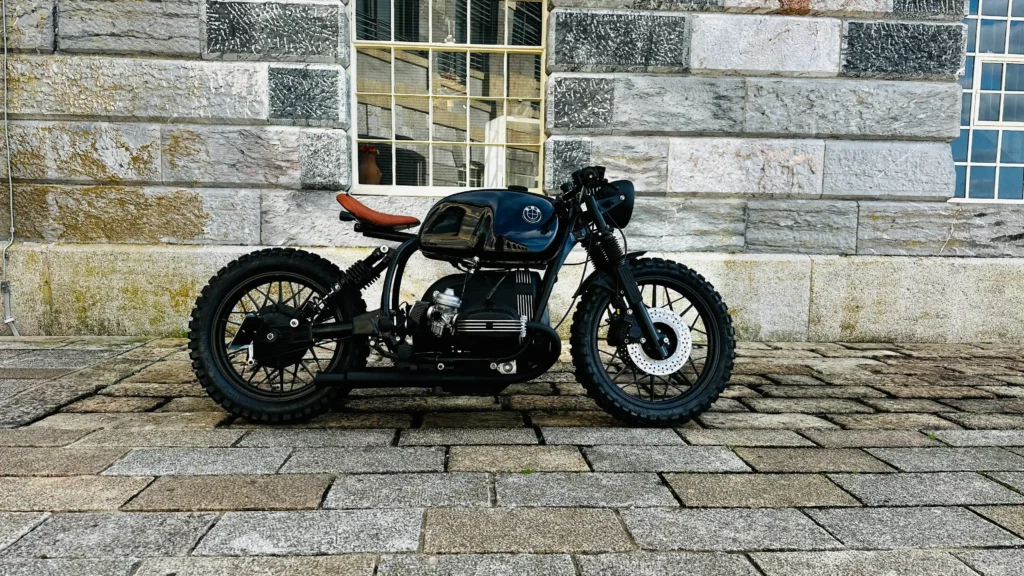Table of Contents
ToggleThe 1988 BMW K100 Café Racer has a unique charm. It’s popular with motorcycle fans and custom builders. Known as the “Flying Brick,” the K100 series—especially the 1988 model—stands out. It combines BMW’s solid engineering with a design that’s great for custom work, making it a top choice for café racer builds. With a strong inline-four engine, a steady frame, and advanced (for its time) fuel injection, the 1988 BMW K100 offers both power and reliability in a classic look.
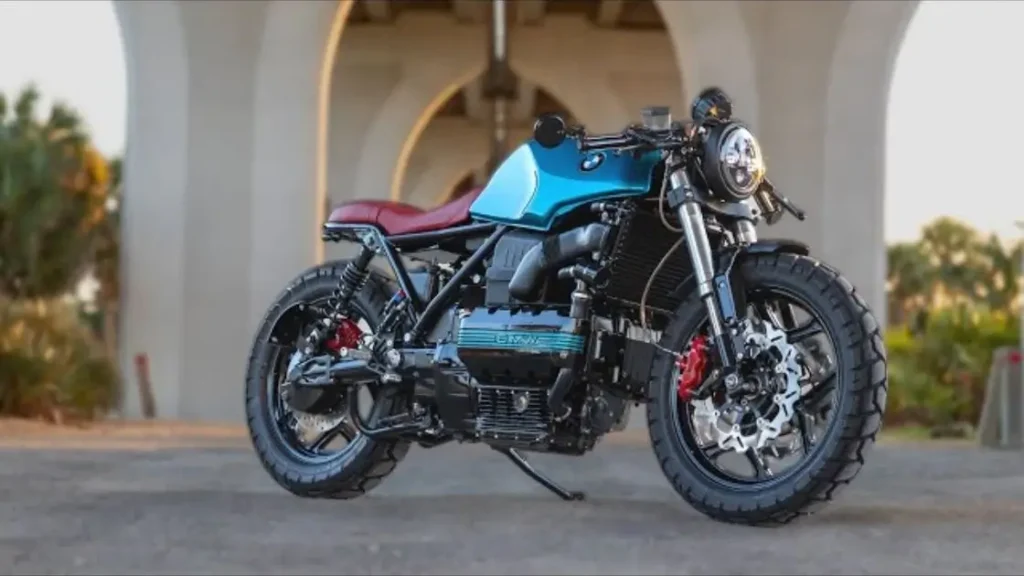
Why is the 1988 BMW K100 great for café racer conversions? First, it has a simple and durable design. Unlike some modern bikes, this model gives builders a blank canvas that’s very adaptable. The K100 has both structure and freedom—qualities that let builders turn its plain frame and parts into sleek, custom café racers. The result? A mix of vintage style with a bit of modern performance, keeping this model popular even today.
In this article, we’ll look at what’s needed to turn a 1988 BMW K100 into a café racer. We’ll cover the key modifications and show examples of amazing custom builds. If you want to take a classic model and make it your own, the 1988 BMW K100 is a great starting point. Let’s dive into the details that make this bike a lasting favorite in the café racer community.
History and Background of the 1988 BMW K100
The 1988 BMW K100 marks a key point in BMW Motorrad’s story. It was part of the K-series, which started in the early 1980s. The K100 was a breakthrough for BMW. Before this, BMW was mainly known for its air-cooled, flat-twin engines. But with the K-series, BMW launched its first liquid-cooled, inline-four engine. This was a big change for performance and engineering.
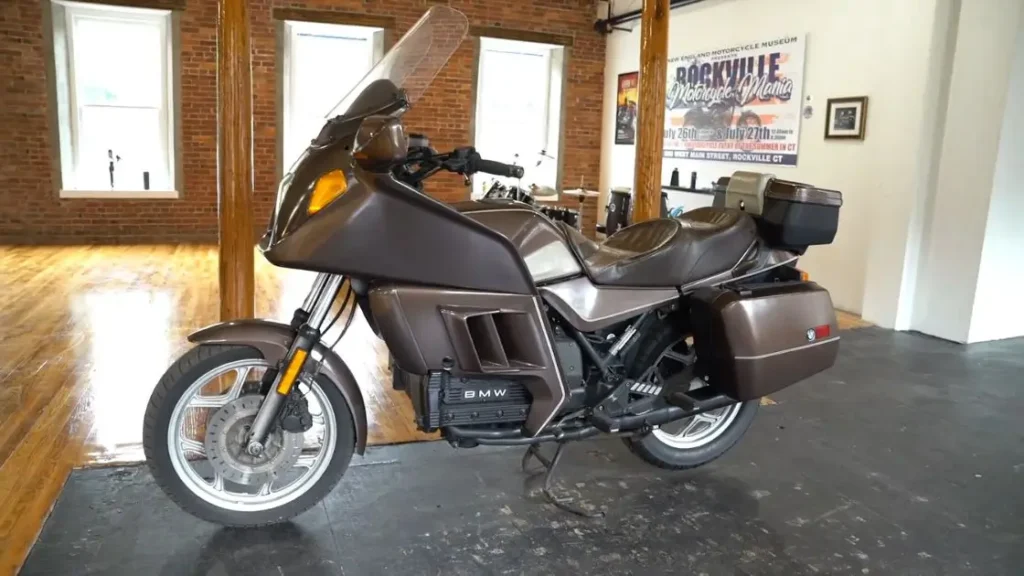
The K100 earned the nickname “Flying Brick” because of its boxy engine shape. This 987cc engine sat on its side, giving the bike a low center of gravity. This layout also made handling better. The bike’s shaft drive system delivered power smoothly, which made it easy to ride long distances. This system also needed little maintenance, making it great for both daily rides and long trips.
In 1988, BMW improved the K100 even more. They upgraded the fuel injection and suspension, which made it faster and more comfortable. These changes made the 1988 K100 a great choice for custom builds, especially café racers. The bike’s simple lines and frame fit the minimalist café racer style, blending looks and performance perfectly.
Today, the 1988 BMW K100 is a symbol of BMW’s move into modern engineering. It’s also a top choice for café racer transformations. The K100’s power, reliability, and flexible design make it a lasting favorite among custom builders who want a classic bike with a unique style.
How Can You Turn the 1988 BMW K100 into a Café Racer?
Turning a 1988 BMW K100 into a café racer is a popular choice among motorcycle fans. This model has a simple design, solid frame, and reliable inline-four engine, making it perfect for customization. Unlike complex bikes, the K100 offers a clean base that can easily be modified to fit the sleek, stripped-down look of a café racer.
The 1988 BMW K100 is appealing because it’s easy to work with. Its inline-four engine and shaft drive make it powerful and low-maintenance. By removing or modifying stock parts, builders can highlight a minimalist look that suits the classic café racer style. The K100’s frame naturally fits a low-profile seat, often paired with a new tail section, giving the bike a distinct, aerodynamic shape.
Many builders have created unique custom café racers using this model. For example, Bay City Restorations built a K100 café racer that blends vintage charm with modern upgrades like better suspension and a custom exhaust. Another standout build by Z17 Customs shows a bold, streamlined design that keeps the K100’s original character while adding sleek, modern touches.
From custom paint jobs to altered lighting and reshaped bodywork, the 1988 BMW K100 is a flexible platform. These builds show how versatile this model can be, transforming from a practical BMW to a stylish, performance-focused café racer that looks great in a showroom or on the road.
Key Modifications for a Cafe Racer Conversion

Converting a 1988 BMW K100 into a café racer requires some key modifications. These changes improve both the look and performance of the bike, turning it into a sleek, fast, and functional machine. Here are the main areas where customizers usually focus:
Aesthetic Enhancements
To achieve the café racer look, builders usually start by changing the bike’s appearance.
- Custom Bodywork and Fairings: Removing the stock fairings gives the bike a clean, stripped-down look. Some builders swap out the fairings or add custom side panels for a more streamlined shape.
- Seat and Tail Section: A traditional café racer has a low-profile seat, often with a single hump or “cowl” at the back. This design matches the bike’s lines and gives it a vintage racing style. Builders often trim down the original seat or add a custom tail section that aligns with the frame.
- Fuel Tank Adjustments: Some custom builds reshape or replace the fuel tank to create smooth lines that flow with the bike’s frame. A slimmer tank emphasizes the K100’s minimalist look, a key part of the café racer style.
Performance Upgrades
To improve speed and handling, builders focus on upgrades that enhance ride quality.
- Suspension Improvements: Upgrading the suspension is common for better ride and handling. Replacing the original forks with lighter, modern ones boosts both performance and comfort.
- Brake System Enhancements: Installing high-quality brakes improves stopping power, which is important for a performance-focused café racer. Many builders upgrade to dual-disc brakes for better and more reliable braking.
Functional Modifications
Functionality matters as much as looks and performance for a café racer. Here are the primary functional changes:
- Lighting and Instrumentation Updates: Most café racer builds replace stock lighting with simpler, more compact options. Small LED headlights and taillights keep a minimalist look while boosting visibility. The large stock instrument cluster is often swapped for a smaller, classic speedometer or a sleek digital gauge.
- Exhaust System Replacements: Switching the stock exhaust for a custom or aftermarket option changes both the sound and look of the bike. A shorter, sleeker exhaust fits the café racer style and gives it a deep, distinct sound that matches the bike’s performance and look.
Each of these modifications serves a purpose, enhancing the bike’s look, performance, and function. Together, they create a classic café racer profile that respects the 1988 BMW K100’s unique design while giving it a fresh, modern edge.
Challenges and Considerations
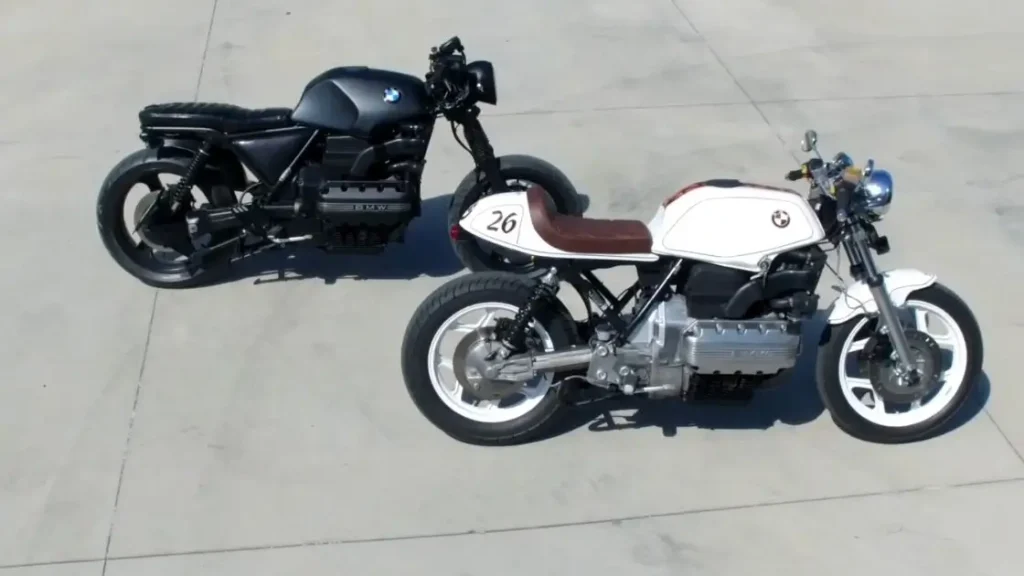
Turning a 1988 BMW K100 into a café racer can be very rewarding. But it also has some challenges. Knowing these obstacles is important before starting a custom build. Let’s look at a few key points to consider.
Technical Challenges
One of the biggest challenges in customizing the K100 is its complex electrical system. Unlike simpler bikes, the K100’s electronics can be tricky to modify without risking reliability issues. Many builders suggest working with someone skilled in motorcycle electronics. This ensures upgrades to lighting, gauges, and other parts work smoothly.
Another challenge is the shaft drive system. While reliable, the shaft drive can limit certain modifications, especially to the rear wheel. Builders need to plan carefully around the shaft drive when adjusting the suspension or making changes to the back of the bike.
Availability of Parts
Since the 1988 BMW K100 is an older model, finding specific parts can be challenging. There is a strong community of enthusiasts who buy, sell, and trade K100 parts. However, certain components, especially custom parts, may be harder to find. Some builders solve this by using aftermarket parts or custom-making pieces to get the perfect fit.
Legal and Safety Considerations
Modifying a bike to match your style is exciting, but safety and legality are important. Café racer conversions often involve changes to lights, brakes, and other key parts. It’s essential to make sure all modifications follow safety rules. For example, use approved lights and indicators and keep the brake function strong. This keeps the bike safe and legal for street riding.
In some places, changing the bike’s look can also affect insurance or registration. Builders should check local laws and, if needed, talk to their insurance provider to avoid any issues.
Cost and Time Commitment
Building a 1988 BMW K100 café racer takes both time and money. Some projects can be done with basic tools and a small budget, but others may need special parts and expert help, which can add to the cost. Planning a realistic budget and timeline keeps the project on track and helps avoid surprises.
These challenges are part of creating a unique café racer. By knowing the potential obstacles and planning ahead, builders can bring their vision for a custom 1988 BMW K100 café racer to life with fewer unexpected issues.
Read More: [1985 BMW K100 Cafe Racer | A Complete Guide]
Case Studies of 1988 BMW K100 Cafe Racers
Looking at real-life custom builds can offer useful insights into the versatility of the 1988 BMW K100 as a café racer. Here are a few standout examples. These builds show different ways to transform this classic model into a unique, performance-focused bike.
Bay City Restorations’ 1988 BMW K100 Cafe Racer
One standout example is the custom 1988 BMW K100 built by Bay City Restorations. This bike blends modern and vintage elements, creating a café racer that’s stylish and functional. Bay City kept the K100’s iconic inline-four engine, emphasizing its power but making changes to the bike’s look.
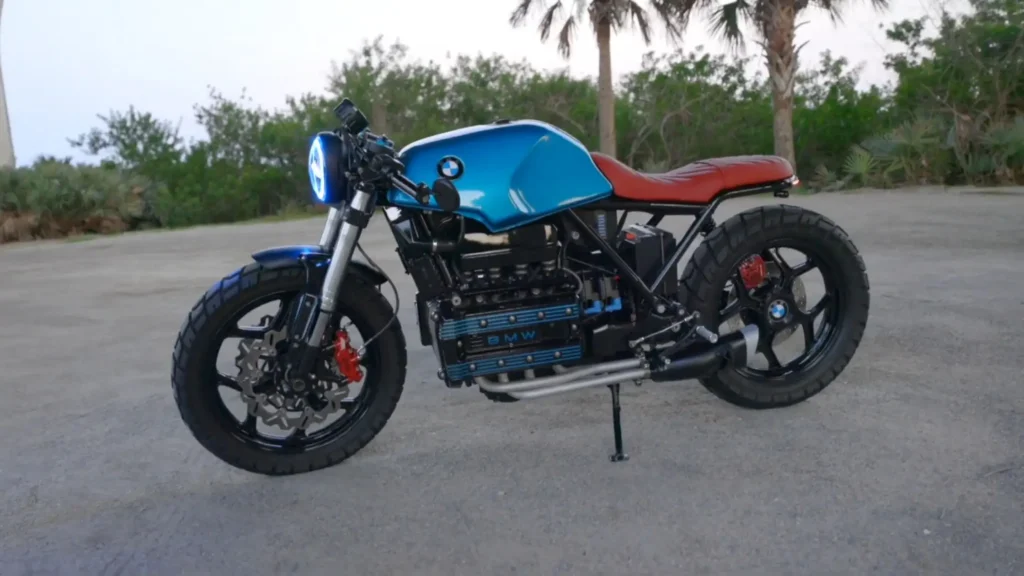
They started by removing the original fairings for a cleaner, open appearance. The seat and tail section were custom-made to fit the frame, featuring a single-seat setup that matches the café racer style. The exhaust was replaced with a shorter, sportier system, giving the bike a deep, bold sound.
Other upgrades included improved front forks for better suspension and handling. Bay City also added a custom LED headlight and a minimalist digital gauge, simplifying the bike’s front end. This build captures the essence of a café racer while keeping the unique character of the K100.
Z17 Customs’ 1988 BMW K100 Cafe Racer
Another impressive build is the 1988 BMW K100 by Z17 Customs. This project combines the original K100 features with a sleek, modern design. Z17 Customs stripped the bike to its essentials, creating a sharp, clean look that highlights the K100’s unique frame and engine.

The fuel tank was reshaped for smoother lines that flow with the bike’s body. A new tail section with a classic hump was added, fitting the café racer style. Z17 also made key performance upgrades, including dual-disc brakes for better stopping power and an enhanced suspension for improved handling.
The lighting setup was redone with a small LED headlight and hidden rear lights, giving a minimalist look. A custom-made exhaust system produces a distinct sound, adding personality to the bike. Z17’s approach shows how the 1988 BMW K100 can be transformed into a refined yet powerful café racer.
These examples show the potential of the 1988 BMW K100 as a café racer. Each build is unique, but all demonstrate how this model’s design, power, and simplicity make it a great base for customization. Builders can find inspiration in these examples, adapting ideas and techniques to fit their own style.
Now, let’s move on to Maintenance and Ownership Tips. This section offers practical advice for keeping a modified 1988 BMW K100 café racer in top condition. We’ll also cover common issues to watch out for.
Maintenance and Ownership Tips
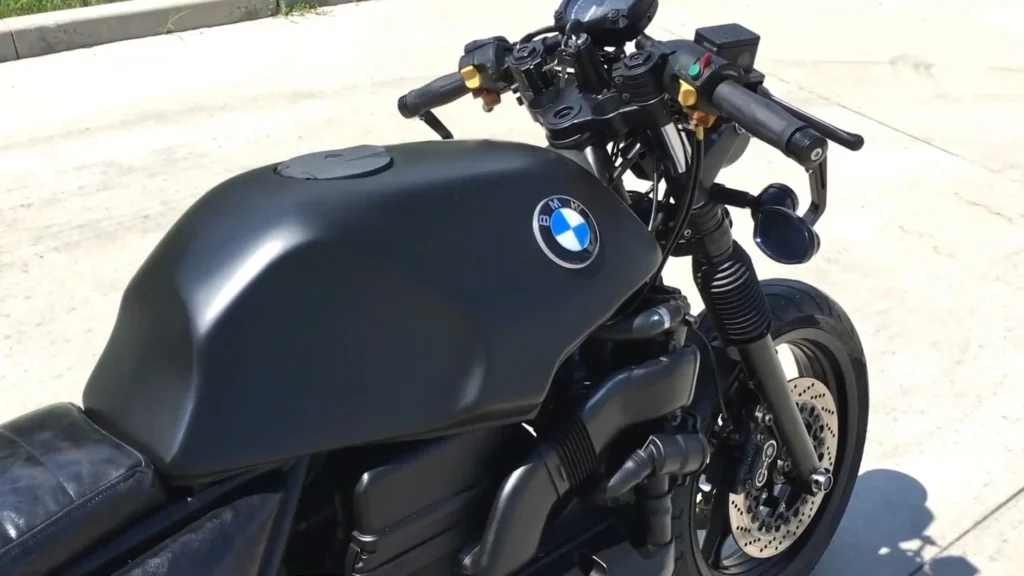
Owning a 1988 BMW K100 Café Racer takes regular care, especially since it’s an older model. While the K100 is reliable, a custom version needs a few extra steps for maintenance. Here are some tips to keep your café racer running well and looking great.
Regular Maintenance Practices
Basic maintenance is crucial for any modified motorcycle, especially a 1988 BMW K100:
- Oil Changes: Regular oil changes are essential for the inline-four engine’s life. The K100 engine heats up fast, so use high-quality oil and change it on schedule.
- Cooling System Checks: The K100 has a liquid-cooled system, so check the coolant level and condition regularly. Look for leaks, and make sure the radiator is in good shape, especially after modifications.
- Brake and Tire Inspections: With the café racer’s performance focus, check the brakes and tires often. Ensure brake pads are in good condition and replace them when needed.
Common Issues and Troubleshooting
Like other classic bikes, the 1988 BMW K100 may have a few common issues. Knowing these can help prevent bigger repairs:
- Electrical Problems: The K100’s electrical system is complex and sensitive to modifications. Problems with lights, gauges, or wiring are common after custom builds. If lights flicker or gauges act up, start by checking the wiring and connectors.
- Fuel Injection System: While generally reliable, the fuel injection system may clog over time. Clean the fuel injectors regularly or use a fuel system cleaner to keep it running well.
- Driveline Maintenance: The K100’s shaft drive system is sturdy but needs occasional care. Check for leaks, keep it lubricated, and inspect drive components to ensure smooth operation.
Community Resources and Support
Owning a custom 1988 BMW K100 Café Racer can be challenging, but there is a strong community of K100 enthusiasts online. Forums, social media groups, and clubs are valuable for advice on maintenance, finding parts, and troubleshooting. Communities like BMW Motorcycle Owners of America (MOA) and dedicated K100 forums are great places to find support, learn from others, and share your café racer journey.
With regular maintenance and early attention to issues, you can enjoy your 1988 BMW K100 Café Racer for years. These tips will help your bike look great and run reliably on the road.
Conclusion
The 1988 BMW K100 Café Racer is a great choice for those who want vintage charm with modern style. With its strong inline-four engine and reliable shaft drive, the K100 is a solid base for a café racer. It’s simple, durable design allows for many custom changes. Builders can change everything from the bodywork and exhaust to the suspension and lights.
We’ve looked at why the 1988 BMW K100 is so popular for café racers. Its unique frame and open layout make it a perfect blank canvas, while its strong engine gives it power beyond just looks. Turning this model into a café racer takes planning and care, but the results can be worth it.
Whether inspired by custom builds from Bay City Restorations or Z17 Customs or by your own ideas, the 1988 BMW K100 offers a great platform to make a one-of-a-kind café racer. It’s a project that blends style, performance, and history, perfect for riders who want a bike that stands out and honors a classic BMW era.
If you’re thinking about this conversion, the 1988 BMW K100 Café Racer gives you the best of both worlds: classic style and strong performance. With the right changes and dedication, this bike can become a true statement of both heritage and modern passion.
FAQs
What makes the 1988 BMW K100 a good base for a café racer?
The 1988 BMW K100, also called the “Flying Brick,” has a strong inline-four engine and a simple frame, making it great for a café racer build.
Are there common challenges when converting a 1988 BMW K100 into a café racer?
Yes, there are a few. The electrical system is complex, and it can be hard to find some parts because of the bike’s age. Modifications also need to follow local safety and legal rules.
What are essential modifications for transforming a 1988 BMW K100 into a café racer?
Key changes often include removing the stock fairings, customizing the seat and tail, upgrading the suspension and brakes, and adding new lighting and instruments.
How can I maintain a modified 1988 BMW K100 café racer?
Regular maintenance is important. This includes timely oil changes, cooling system checks, and frequent brake and tire inspections. Knowing about common issues, like electrical problems, and joining enthusiast groups can also help.

